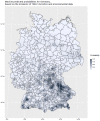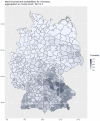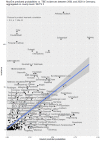Decoding the Geography of Natural TBEV Microfoci in Germany: A Geostatistical Approach Based on Land-Use Patterns and Climatological Conditions
- PMID: 36142105
- PMCID: PMC9517139
- DOI: 10.3390/ijerph191811830
Decoding the Geography of Natural TBEV Microfoci in Germany: A Geostatistical Approach Based on Land-Use Patterns and Climatological Conditions
Abstract
Background: Tickborne-encephalitis (TBE) is a potentially life-threating neurological disease that is mainly transmitted by ticks. The goal of the present study is to analyze the potential uniform environmental patterns of the identified TBEV microfoci in Germany. The results are used to calculate probabilities for the present distribution of TBEV microfoci in Germany based on a geostatistical model. Methods: We aim to consider the specification of environmental characteristics of locations of TBEV microfoci detected in Germany using open access epidemiological, geographical and climatological data sources. We use a two-step geostatistical approach, where in a first step, the characteristics of a broad set of environmental variables between the 56 TBEV microfoci and a control or comparator set of 3575 sampling points covering Germany are compared using Fisher's Exact Test. In the second step, we select the most important variables, which are then used in a MaxEnt distribution model to calculate a high resolution (400 × 400 m) probability map for the presence of TBEV covering the entire area of Germany. Results: The findings from the MaxEnt prediction model indicate that multi annual actual evapotranspiration (27.0%) and multi annual hot days (22.5%) have the highest contribution to our model. These two variables are followed by four additional variables with a lower, but still important, explanatory influence: Land cover classes (19.6%), multi annual minimum air temperature (14.9%), multi annual sunshine duration (9.0%), and distance to coniferous and mixed forest border (7.0%). Conclusions: Our findings are based on defined TBEV microfoci with known histories of infection and the repeated confirmation of the virus in the last years, resulting in an in-depth high-resolution model/map of TBEV microfoci in Germany. Multi annual actual evapotranspiration (27%) and multi annual hot days (22.5%) have the most explanatory power in our model. The results may be used to tailor specific regional preventive measures and investigations.
Keywords: Ixodes ricinus; MaxEnt; TBE; TBEV; climatological data; environmental variables; geostatistical approach; land-use patterns; microfocus; prediction model; tick-borne encephalitis.
Conflict of interest statement
The authors declare no conflict of interest.
Figures








Similar articles
-
Annual and seasonal variation of tick-borne encephalitis virus (TBEV) prevalence in ticks in selected hot spot areas in Germany using a nRT-PCR: results from 1997 and 1998.Zentralbl Bakteriol. 1999 Dec;289(5-7):564-78. doi: 10.1016/s0934-8840(99)80010-3. Zentralbl Bakteriol. 1999. PMID: 10652722
-
Characterization of tick-borne encephalitis (TBE) foci in Germany and Latvia (1997-2000).Int J Med Microbiol. 2002 Jun;291 Suppl 33:34-42. doi: 10.1016/s1438-4221(02)80007-8. Int J Med Microbiol. 2002. PMID: 12141755
-
Tick burden on European roe deer (Capreolus capreolus) from Saxony, Germany, and detection of tick-borne encephalitis virus in attached ticks.Parasitol Res. 2020 Apr;119(4):1387-1392. doi: 10.1007/s00436-020-06637-z. Epub 2020 Mar 24. Parasitol Res. 2020. PMID: 32211989
-
Why is tick-borne encephalitis increasing? A review of the key factors causing the increasing incidence of human TBE in Sweden.Parasit Vectors. 2012 Aug 31;5:184. doi: 10.1186/1756-3305-5-184. Parasit Vectors. 2012. PMID: 22937961 Free PMC article. Review.
-
Food-Borne Transmission of Tick-Borne Encephalitis Virus-Spread, Consequences, and Prophylaxis.Int J Environ Res Public Health. 2022 Feb 5;19(3):1812. doi: 10.3390/ijerph19031812. Int J Environ Res Public Health. 2022. PMID: 35162837 Free PMC article. Review.
Cited by
-
The Prevalence of Tick-Borne Encephalitis Virus in Wild Rodents Captured in Tick-Borne Encephalitis Foci in Highly Endemic Lithuania.Viruses. 2024 Mar 13;16(3):444. doi: 10.3390/v16030444. Viruses. 2024. PMID: 38543809 Free PMC article.
-
First Expert Elicitation of Knowledge on Possible Drivers of Observed Increasing Human Cases of Tick-Borne Encephalitis in Europe.Viruses. 2023 Mar 20;15(3):791. doi: 10.3390/v15030791. Viruses. 2023. PMID: 36992499 Free PMC article.
-
Revealing the Tick Microbiome: Insights into Midgut and Salivary Gland Microbiota of Female Ixodes ricinus Ticks.Int J Mol Sci. 2023 Jan 6;24(2):1100. doi: 10.3390/ijms24021100. Int J Mol Sci. 2023. PMID: 36674613 Free PMC article.
-
Different environmental factors predict the occurrence of tick-borne encephalitis virus (TBEV) and reveal new potential risk areas across Europe via geospatial models.Int J Health Geogr. 2025 Mar 14;24(1):3. doi: 10.1186/s12942-025-00388-9. Int J Health Geogr. 2025. PMID: 40087786 Free PMC article.
-
Interrelation of the spatial and genetic structure of tick-borne encephalitis virus, its reservoir host (Myodes glareolus), and its vector (Ixodes ricinus) in a natural focus area.Ecol Evol. 2024 Aug 19;14(8):e70163. doi: 10.1002/ece3.70163. eCollection 2024 Aug. Ecol Evol. 2024. PMID: 39165543 Free PMC article.
References
-
- Ruzek D., Avšič Županc T., Borde J., Chrdle A., Eyer L., Karganova G., Kholodilov I., Knap N., Kozlovskaya L., Matveev A., et al. Tick-borne encephalitis in Europe and Russia: Review of pathogenesis, clinical features, therapy, and vaccines. Antivir. Res. 2019;164:23–51. doi: 10.1016/j.antiviral.2019.01.014. - DOI - PubMed
Publication types
MeSH terms
LinkOut - more resources
Full Text Sources

